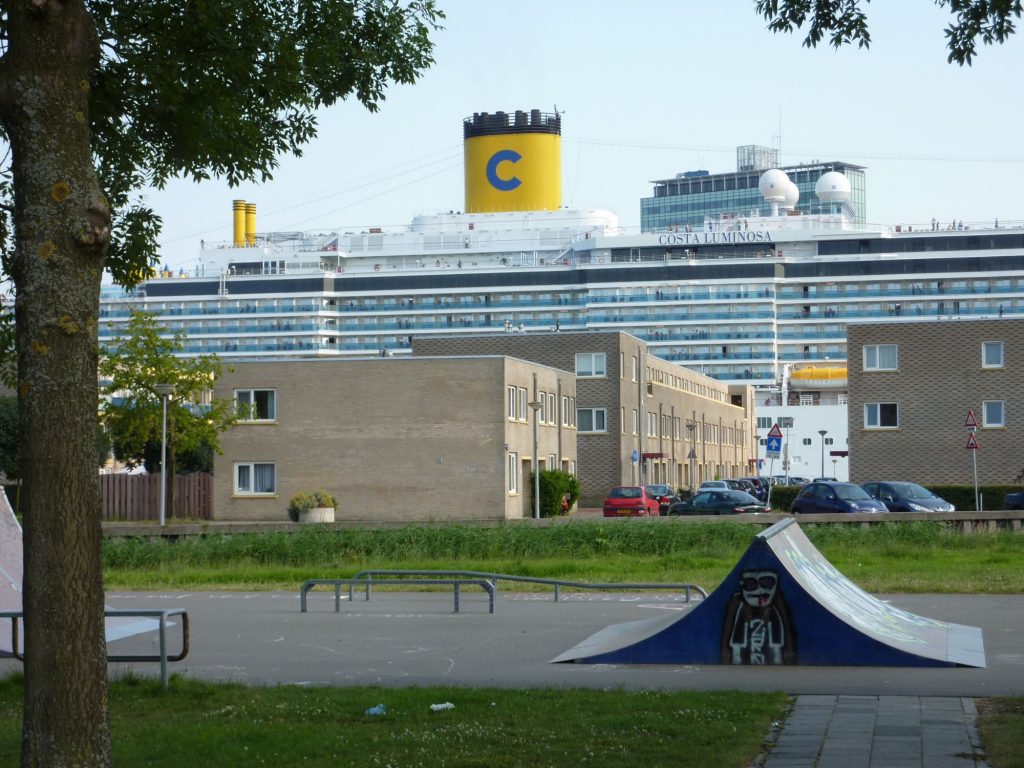… accept that there is no recipe, but there might well be some sensible principles. The situation is dire, our profession is in crisis and attacked from all parts. We are forced to redefine it, says Oana Bogdan, but that may be a blessing in disguise. A sharp and well-documented essay about work, the market, responsibility, identity and 7 steps for change.
Text: Oana Bogdan
Photo: Leo van Broeck
Graphics: Bogdan & Van Broeck
… understand the market,
Architecture is strongly linked to the economic context and the financial market, due to the construction sector, which is also a lead economic indicator. As such, the economic crisis had a severe impact on the architectural profession in Europe: for a decrease in GDP below 2% between 2008 and 2012, the construction market has fallen by 10% and the architectural market by 28%, which proves how sensitive the architectural profession is to changes in the economy.
Next to the volatile economic environment, the architectural market is affected by the undervaluing of architectural services. Today’s society is not really aware of the workload and the tasks of the architect. The perception is that architects only make drawings and mainly decide on the aesthetics of buildings, and this leads to a general lack of acknowledgement of the “value of design”, which often can only be measured after construction. In reality though, architects are confronted with a huge amount of constraints and rules: urban regulations, proximity of other functions and programs, the financial feasibility of a project, mobility issues, accessibility to people with handicaps, ecological and energetic standards, building site security and site supervision, the circulation of air, the elimination of waste water and garbage, and safeguard against potential threats from fire, the extremes of nature, and criminal activities.
Customers are often unaware of these different kinds of activities architects are responsible for and their added value, which makes it difficult to justify a representative fee. Furthermore, architects are not trusted when it comes to their timing and correct assessment of budgets, therefore, part of their mission has been given to project managers and quantity surveyors. This results in an additional decrease of absolute fees.
Last but not least, a fair amount of wasted effort in architecture is caused by unpaid or badly paid competitions . Architects’ creations compete against other architect’s creations with at least a 80% chance to not win. As the core of architectural business is to provide good ideas and concepts, this is exactly what is delivered for free in unpaid or badly paid competitions.
 *The cruise ship Costa Luminosa in the centre of Amsterdam
*The cruise ship Costa Luminosa in the centre of Amsterdam
…question architecture,
The architectural profession is based on three knowledge sectors that generate paradoxes and tensions: arts and human sciences, positive sciences, economy and business administration. If until a few decades ago architects were “master builders”, today they provide zoning analysis, demographic scrutiny, material wisdom, procurement expertise, spatial adaptability, organizational expertise, manufacturing awareness, sustainability education, cost analysis.
Architects are idea creators who do not build, but generate ideas about buildings. Therefore, architecture is in the first place a creative industry. Creative industries are those industries which have their origin in individual creativity, skill and talent, and rank among the fastest-growing sectors of the global economy and contribute significantly to employment and wealth creation. Professionals working in creative industries often lack the necessary managerial skills to thrive in such complex and turbulent businesses. Architectural practices share the lack of business skills with other organizations from the creative industries, as architecture schools do little to foster entrepreneurship.
Unlike the other creative industries, architecture is also a liberal profession. This means that it is protected and at the same time limited in its economic ambitions by a deontology that obliges architects to hold the common interest of society higher than the proper financial interests. Architects are licensed professionals who provide services within the limits of accepted professional norms, governing standards and legislation such as building codes, land use by-laws and similar regulation. Since buildings and other structures are centres of human activity, architectural designs need to ensure the health, safety, and security of the people who will spend time in and around the buildings. This is the main reason why architects are required to be licensed.
Architecture may be an art, but it is also a service profession. To become a good architect requires a passionate dedication to the creative design process. To become a successful one means also understanding that it’s a business, a unique one perhaps, but still a business. In their quest to improve their professional performance, architects are too busy to reflect upon their business. Too often architectural practices successful on a professional level struggle to be successful on a business level. The reason for that is threefold: lack of business savviness amongst architects, undervaluing of architectural services and unprecedented global challenges.
In the conclusions of RIBA’s Business Benchmarking 2013/14, two business models representative of the architectural profession are highlighted: small scale architectural practices serving mainly the residential market and large scale architectural practices working on large scale private and public buildings. The mid-size architectural practices have closed down or downscaled, given the difficult economic landscape of recent years – economic crises polarize a market, which mainly concerns medium-sized practices.
 *Panorama of the City of La Paz, taken from the south east. Left, the city centre. Top left the inhabited sprawled hills that rise towards the high plains of El Alto at more than 4,000 meters altitude. The landscape, although systematically altered by landslides, is increasingly covered by informal settlements.
*Panorama of the City of La Paz, taken from the south east. Left, the city centre. Top left the inhabited sprawled hills that rise towards the high plains of El Alto at more than 4,000 meters altitude. The landscape, although systematically altered by landslides, is increasingly covered by informal settlements.
…and transform it in seven steps. Let us hear about seven calls for the architect:
Step 1: Let’s produce actions!
Etymologically, the word “architect” derives from the Latin “architectus”, which derives from the Greek “arkhitekton” (arkhi-, chief + tekton, builder), i.e., chief builder. Today architecture is not only an activity of making buildings anymore, but must provide a wide mirror view of how the man-made world could be organised. Therefore architecture’s horizon expands beyond buildings and becomes more a process than only the building of a product: people, cities, places, activities, scenarios, politics, sociology, culture and sciences broaden the picture. This is the designer’s new world, which is not necessarily about producing artefacts, but producing actions.
Step 2: Let’s get to the forefront of the sustainability agenda!
Sustainability requires far more than new technology. It requires that we look at buildings as nodes within vast ecologies – social, natural, economic, cultural, political, perceptual – and design them within that understanding. As a consequence, the definition of sustainable design has evolved to encompass issues beyond natural resources and the environment.
There are huge challenges to consider in areas of population explosion, food security, energy crises, socio-economic instability, disease outbreaks, and strategies for housing. Under the leadership of visionary leaders and environmental scanning sciences, some architectural practices will become sought after for trend analysis work which will impact urban design, planning, and climate change mitigation.
Step 3: Let’s collaborate!
The contemporary planning process is complex – particularly in urban and architectural design: planning becomes nearly impossible due to political complexity; project schedules are getting shorter and shorter; building types are getting more complex; there is a lack of surety over the scope of and costs for architectural work; there is an increased complexity of coordination between consultants; there is an increasing disconnection between client and designer.
Projects based on planning and design are increasingly torn between the conflicting goals and interests of the key actors. In order to manage complexity, communication and collaboration methodologies will become indispensable. As such, the traditional role of the designer as “master builder” is over: the development of the built environment is not a solitary act of creativity but a collaborative phenomenon between society, community, politics, economy and technical expertise within the constraints of the environment.
Step 4: Let’s take stock of the value we create!
Architects could define their services around the success of their customers, as doctors and lawyers do. So far most architects failed to do so and charge an almost flat fee, regardless of design talent.
The industry must break out of its old economic model: architecture firms should move away from selling hours, and instead take stock of what value they are creating for clients. We cannot always control the changes that affect us, but we can evolve in the way we create value. Understanding the way in which the market shifts and changes, and defining this value, can create new opportunities.
Step 5: Let’s offer consultancy!
Next to new pricing models for design services, there are alternative services and, together with them, the opportunity to break out of traditional pricing models. Consultancy could be such an alternative service.
Step 6: Let’s take the lead!
Since 2005 design as a practice continues to create tremendous value and offer transformative models that other fields can benefit from. One of the broadest design thinking frameworks is the matrix developed by Richard Buchanan, who stated that “sharing of ideas and practice between design and management creates an exciting challenge”. Unlike scientists, who sift through facts to discover insights, designers invent new patterns and concepts to address facts and possibilities.
As today leaders must cultivate the ability to operate through convulsive and unexpected change, “design thinking” is being replaced by “design leadership”- the idea that business and management should not only adopt ideas from the design process and approach, but also that design-based professions can lead other disciplines in creative solutions to large and complex problems in business and the world.
Step 7: Let’s get involved in policy making!
Today modern architecture’s social mission defined by the Modern Movement in the last century – the effort to establish a decent standard of living for all – has been replaced by wealth, speculation and marketing. Architecture has become a tool of capital. If before the 1970s buildings were primarily regarded as a public expenditure, after the 1970s buildings became more a mean of revenue, something to own in the hope for increased asset value instead of actual use value. This contributed to the increasing pressure on construction budgets and led to an architecture based on short-term profits. Through the general deployment of the term “real estate”, the economist replaces the role of the architect,the logic of a building serves mostly to promote desirability in economic terms and architecture is worth whatever others are willing to pay for it.
The state is increasingly taking a reactive approach to planning and is placing more responsibility on private partners, research institutions, financial groups and non-government associations. As the influence of the public sector is steadily declining, initiatives to construct the city increasingly reside within the private sector. Designing a city becomes a strategic exercise driven by economic considerations, rather than a planning effort driven by spatial parameters, leading to the collapse of an adequate, comprehensive system of planning.
As we have entrusted in the market economy so much power to decide how cities come out, cities are confronted with a fundamental problem, which calls for a political change and is an opportunity for architects to get involved in policy making.
“If you really want to change the city, (…) then it would require re-engaging with things like public planning for example, or re-engaging with government, or re-engaging with large-scale institutionalised developers. I think that’s where the real struggles lie, that we re-engage with these structures and these institutions, this horribly complex ‘dark matter’.” – Wouter Vanstiphout, 2010
…..
Oana Bogdan has 16 years of experience in the private sector, mainly as a founding partner in the award-winning architecture firm BOGDAN & VAN BROECK (bogdanvanbroeck.com). In 2016, she worked as a Secretary of State in charge of Heritage at the Ministry of Culture in Romania.
…..
Bibliography
BuroHappold Engineering – International Engineering Consultants. “AIA Chicago: Future Success; the Changing Context, Business and Practice of Architecture – BuroHappold Engineering.” March 31, 2015. Web. April 2, 2015
Creative Industries Task Force.“Creative Industries Mapping Document.” London: Department for Culture, Media and Sport, 2001
De Graaf, Reinier. “Architecture is now a tool of capital, complicit in a purpose antithetical to its social mission.”, Architectural Review. 24 April 2015.
Granet, Keith. The Business of Design. 1st ed. New York: Princeton Architectural Press. 2011
Hustwit, Gary. “Rem Koolhaas: There’s Been Very Little Rethinking Of What Cities Can Be.” Helvetica/Objectified/Urbanized: The Complete Interviews Web. May 12, 2015
Jacob, Mickey and Ivy Robert. “AIA Foresight Report. The Changing Context, Business, and Practice of Architecture 2013.” The American Institute of Architects. Web. December 4, 2014,
Robinson, David. Building Futures report: ‘The Future for Architects?’. Royal Institue of British Architects, 2011
Slocum, David. “Seven Tyrannies That Creative Leaders Must Overcome.” Forbes. April 2, 2015. Web. April 3, 2015
The Architects’ Council of Europe. “The Architectural Profession in Europe 2014. A sector study.” Mirza & Necey Research Ltd. United Kindom : January 2015. Web. February 12, 2015
The Royal Institute of British Architects. “The RIBA Business Benchmarking Survey. Answering the questions every practice should be asking.” London. Web. May 2, 2015
Vault. “Architecture. Review.” Web. April 3, 2015,
Week, David. “Five Principles of Lean Building Design – Architecture for Development.“Architecture for Developme — From Concepts to Fieldwork. September 28, 2010. Web. November 21, 2014




